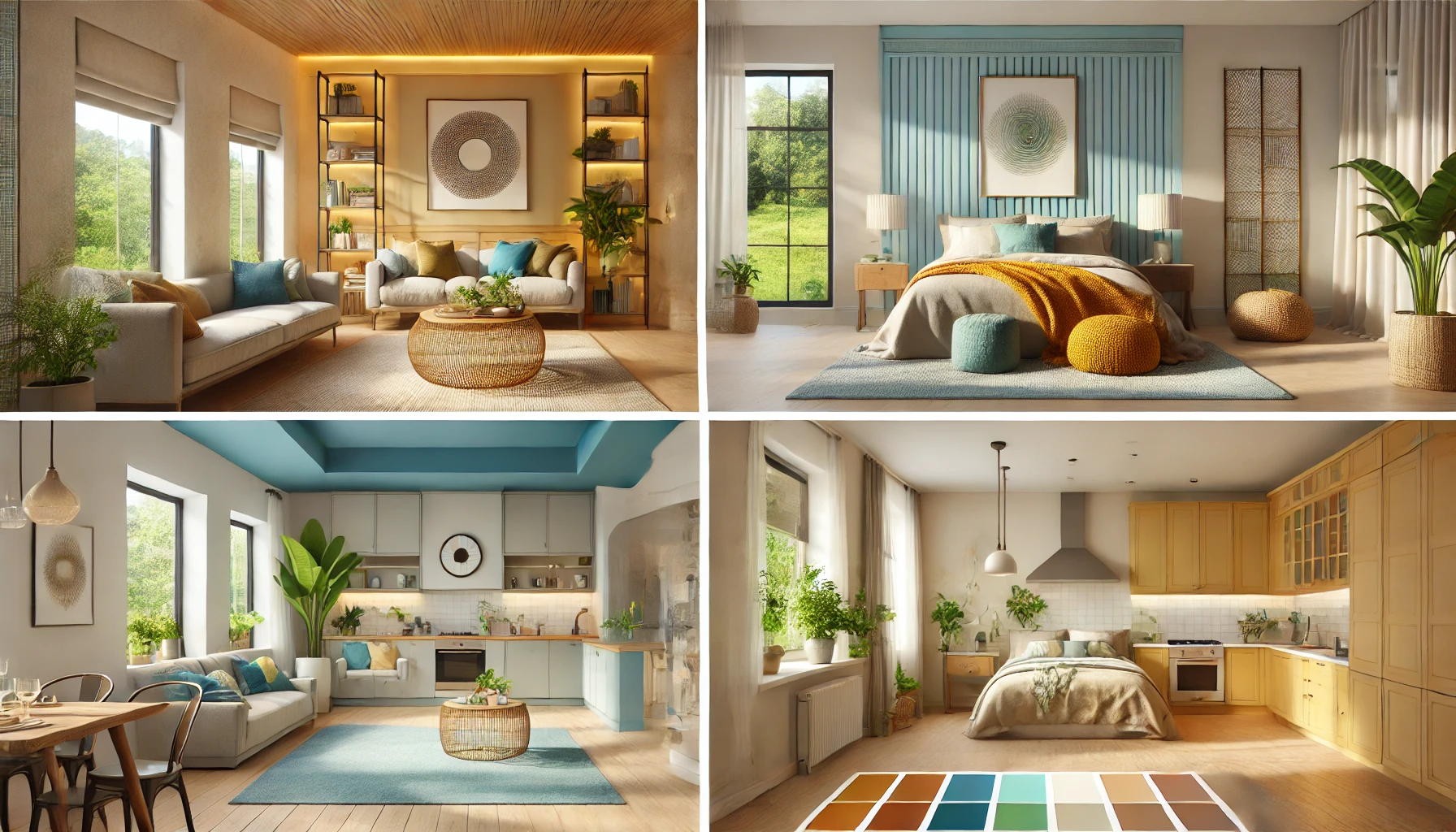Color plays a crucial role in Feng Shui, influencing energy flow and the overall atmosphere of a space. Each color corresponds to one of the five Feng Shui elements—Wood, Fire, Earth, Metal, and Water—affecting emotions, productivity, and well-being. Choosing the right colors for each room helps create balance, harmony, and positive energy in your home.
Understanding Feng Shui Colors and Their Meanings
Feng Shui colors are associated with specific elements and have unique effects on a space. Here are the primary colors and their meanings:
- Red (Fire) – Passion, energy, and motivation
- Orange (Fire) – Creativity, warmth, and enthusiasm
- Yellow (Earth) – Stability, nourishment, and happiness
- Green (Wood) – Growth, healing, and renewal
- Blue (Water) – Calmness, wisdom, and relaxation
- Black (Water) – Depth, sophistication, and mystery
- White (Metal) – Purity, clarity, and new beginnings
- Gray (Metal) – Balance, focus, and neutrality
- Brown (Earth) – Security, grounding, and comfort
- Purple (Fire & Wealth) – Spirituality, luxury, and abundance
By understanding these color meanings, you can apply them strategically to different rooms to enhance their energy.
The Best Colors for Each Room in Feng Shui
1. Living Room: Warm and Inviting Energy
The living room is a gathering space where family and guests interact, making it important to choose colors that encourage connection and comfort.
Recommended Colors:
- Earth tones like beige, warm yellows, and soft browns create a cozy and welcoming atmosphere
- Light green or soft blue promotes relaxation and harmony
- Red or orange accents can add energy but should be used in moderation
Avoid overly dark colors, as they can create a heavy or closed-off feeling.
2. Bedroom: Relaxation and Romance
The bedroom should be a peaceful sanctuary that promotes rest and intimacy. Soft, soothing colors work best in this space.
Recommended Colors:
- Light blues and greens encourage calmness and restful sleep
- Soft pink or peach supports love and relationships
- Earth tones like beige and warm taupe provide grounding and comfort
Avoid bright red or dark colors, as they can be too stimulating for restful sleep.
3. Kitchen: Nourishment and Vitality
The kitchen represents nourishment and health, so colors that stimulate appetite and warmth are ideal.
Recommended Colors:
- Warm yellows and oranges promote happiness and social interaction
- Soft greens represent fresh ingredients and vitality
- Earth tones like beige and terracotta create a grounded and stable environment
Avoid too much blue or black, as these colors suppress appetite.
4. Dining Room: Connection and Abundance
The dining room is where meals are shared, making it a space that benefits from colors that promote conversation and prosperity.
Recommended Colors:
- Deep reds and warm oranges stimulate appetite and engagement
- Golden yellow encourages warmth and a sense of abundance
- Soft earthy tones create an inviting and relaxed dining experience
Avoid overly dark colors, which may dampen the mood.
5. Bathroom: Cleansing and Renewal
Bathrooms symbolize cleansing and renewal, so they should have colors that enhance freshness and relaxation.
Recommended Colors:
- Light blue or aqua for a spa-like, refreshing atmosphere
- White or pastel tones to enhance cleanliness and clarity
- Soft green for a natural and rejuvenating effect
Avoid too much black or red, as they can create an overwhelming or unsettling energy.
6. Home Office: Productivity and Focus
A home office needs colors that enhance focus, creativity, and motivation while reducing stress.
Recommended Colors:
- Light blues or soft greens for concentration and calmness
- White or gray for clarity and mental focus
- Pops of yellow or orange to spark creativity and energy
Avoid overly bright or distracting colors, which may reduce efficiency.
7. Hallways and Entryways: Smooth Energy Flow
Hallways and entryways guide energy into the home and connect different spaces. Choosing the right colors helps ensure a smooth flow of positive Chi.
Recommended Colors:
- Soft neutrals like beige, white, or light gray for a balanced, open feel
- Pastel or warm tones to create a welcoming atmosphere
- Green plants or earthy elements to refresh the energy
Avoid very dark or heavy colors, which can make the space feel narrow or unwelcoming.
8. Children’s Room: Creativity and Growth
Children’s rooms should feel inspiring, playful, and restful at the same time.
Recommended Colors:
- Light green for growth and learning
- Soft blue for calmness and emotional balance
- Warm yellow for energy and happiness
Avoid overly bright or dark colors, which can overstimulate or create anxiety.
9. Outdoor Spaces: Connection to Nature
Outdoor areas, such as patios and gardens, should harmonize with nature and promote relaxation.
Recommended Colors:
- Earthy greens and browns for a natural and grounded feel
- Blues and whites for a serene outdoor experience
- Bright floral colors to add vibrancy and joy
Avoid too many artificial or overly bold colors that disrupt the natural environment.
Final Thoughts: Choosing the Right Feng Shui Colors for Your Home
Selecting colors in alignment with Feng Shui principles helps create a balanced and harmonious living environment. Each color carries a unique energy that influences emotions and interactions, so choosing the right shades for each room enhances well-being and positivity.
When applying Feng Shui colors, consider combining them with the five elements to create balance. Small touches, such as accent walls, furniture, or decorative items, can make a big difference in transforming the energy of your home.
